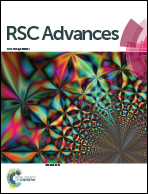Magnetic Co–Fe bimetallic nanoparticle containing modifiable microgels for the removal of heavy metal ions, organic dyes and herbicides from aqueous media
Abstract
Poly(methacrylic-co-acrylonitrile) (p(MAc-co-AN)) microgels were prepared and nitrile groups were converted to amidoxime groups by chemical modification. Amidoximated microgels, amid-p(MAc-co-AN) microgels were used for in situ synthesis of cobalt–iron (Co–Fe) bimetallic magnetic nanoparticles by simultaneous reduction of Co(II) and Fe(II) ions within microgel. The prepared magnetic microgels as amid-mag-p(MAc-co-AN) microgel were found to be very effective adsorbents for the removal of metal ion such as Cd(II), Cr(III), and organic dyes e.g., methylene blue (MB), rhodamine 6G (R6G) and a herbicide, paraquat (PQ). A tremendous increase in the adsorption capacities of amid-p(MAc-co-AN) microgels was found as 88.1, 89.9, 190.0, 334.5 and 166.5 mg g−1 from 40.2, 37.4, 75.3, 57.4, and 56.3 for MB, R6G, PQ, Cd(II), and Cr(III), respectively. Moreover, a further increase in adsorption capacity of amid-mag-p(MAc-co-AN) microgel composites were also accomplished with the existence of magnetic particles. Adsorption of these contaminants from tap, river and seawater was also studied. The effects of different parameters i.e., pH, concentration of adsorbent solution and amount of adsorbate was also studied. Langmuir, Freundlich and Temkin adsorption models were applied, and the adsorption of Cd(II) and Cr(III) was found to obey Langmuir adsorption isotherm better.


 Please wait while we load your content...
Please wait while we load your content...